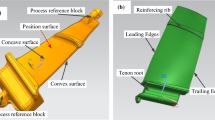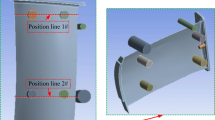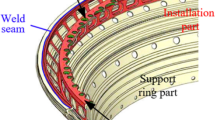Abstract
Low stiffness of the near-net-shaped blade machining fixture of aero-engine creates challenges for the CNC machining accuracy and efficiency of near-net-shaped blade. This study aims to optimize the fixture’s material and structure to improve the stiffness of the blade-fixture system. First, the main influencing factors of the near-net-shaped blade tenon root CNC machining process were analyzed, and the influences of the positioning and clamping component materials and structures on the stiffness of the machining fixture were analyzed based on finite element analysis (FEA). Second, the mechanical properties of the positioning and clamping components of different materials and structures were analyzed based on cross-scale analysis from microscopic and macroscopic perspectives. Finally, the positioning and clamping components of the machining fixture were designed based on material selection and structure optimization, and the optimized machining fixture with new material and structural was verified by CNC machining process. The results showed that the material and structure of the positioning and clamping components were the main influencing factors of the machining fixture stiffness. The positioning and clamping components of the PEEK-GF30 material of the new splicing structure could effectively improve the blade-fixture stiffness.













Similar content being viewed by others
Data availability
Not applicable.
Code availability
Not applicable.
References
Lin XJ, Wu DB, Yang BY, Wu G, Shan X, Xiao Q, Hu L, Yu J (2017) Research on the mechanism of milling surface waviness formation in thin-walled blades. Int J Adv Manuf Technol 93:2459–2470
Wu D, Wang H, Zhang K (2020) Research on flexible adaptive CNC polishing process and residual stress of blisk blade. Int J Adv Manuf Technol 103:2495–2513
Wu D, Wang H, Zhang K, Zhao B (2020) Research on adaptive CNC machining arithmetic and process for near-net-shaped jet engine blade. J Intell Manuf 31:717–744
Marini D, Cunningham D, Corney JR (2018) Near net shape manufacturing of metal: a review of approaches and their evolutions. Proc Inst Mech Eng B J Eng Manuf 232(4):650–669
Wu D, Wang H, Yu J, Zhang K (2020) Machining fixture for adaptive CNC processing technology of near-net-shaped jet engine blade. Chin J Aeronaut 33:1311–1328
Gandhi MV, Thompson BS (1984) Phase-change fixturing for FMS. Manuf Eng 93(6):79–80
Smith S, Wilhelm R, Dutterer B, Cherukuri H, Goel G (2012) Sacrificial structure pre-Forms for thin part machining. CIRP Ann Manuf 61:379–382
Feia J, Lina B, Xiaob J et al (2018) Investigation of moving fixture on deformation suppression during milling process of thin-walled structures. J Manuf Process 32:403–411
Wang H, Zhou MX, Yu J, Wang W, Huang B, Rong YM (2016) Numerical modeling and analysis of positioning error in aero-engine blade conformal machining. Comput Integr Manuf Syst 22(9):2118–2126 [Chinese]
Hamedi M (2005) Intelligent fixture design through a hybrid system of artificial neural network and genetic algorithm. Artif Intell Rev 23:295–311
Lu C, Zhao HW (2015) Fixture layout optimization for deformable sheet metal workpiece. Int J Adv Manuf Technol 78(1-4):85–98
Sundararaman K, Padmanaban K, Sabareeswaran M (2016) Optimization of machining fixture layout using integrated response surface methodology and evolutionary techniques. Proc Inst Mech Eng C J Mech Eng Sci
Siebenaler SP, Melkote SN (2006) Prediction of workpiece deformation in a fixture system using the finite element method. Int J Mach Tool Manu 46:51–58
Kulanlara K, Melkote SN (2000) Machining fixture layout optimization using the genetic algorithm. Int J Mach Tools Manuf 40(4):579–598
Qin G, Zhang W, Wan M (2006) Analysis and optimal design of fixture clamping sequence. Trans ASME 128:482–493
Deng HY, Melkote SN (2006) Determination of minimum clamping force for dynamically stable fixturing. Int J Mach Tools Manuf 46:847–857
RadhaMadhavi C, Ramu B, Srinivasulu K (2014) Design of machining fixture for turbine rotor blade. Int J Res Eng Technol 3:1–14
Wang Y, Chen X, Gindy N, Xie J (2008) Elastic deformation of a fixture and turbine blades system based on finite element analysis. Int J Adv Manuf Technol 36(3- 4):296–304
Ren JX, Feng YZ, Mi XP et al (2015) Adaptive techniques in CNC machining of aero-engine precision forging blades. Aeronaut Manuf Technol 22:52–59 (in Chinese)
Wang H, Peng JS, Zhao B (2019) Modeling and performance analysis of machining fixture for near-net-shaped jet engine blade. Assem Autom 39(4):624–635
Wu D, Wang H, Peng J et al (2019) Machining fixture for adaptive CNC machining process of near-net-shaped jet engine blade. Chin J Aeronaut S1000-9361:30252–30253
Lucas BN, Oliver WC (1999) Indentation power-law creep of high-purity indium. Metall Mater Trans A 30:601–610
Poisl WH, Oliver WC, Fabes BD (1995) The relationship between indentation and uniaxial creep in amorphous selenium. Mater Res Soc 10(8): 2024-2032.
Funding
This research was supported in part by Xi’an Aero-Engine (Group) Ltd. and the National Natural Science Foundation of China [grant number 51575310].
Author information
Authors and Affiliations
Contributions
Hui Wang: methodology, formal analysis, original draft writing
Kaiyao Zhang: experiment, simulated analysis, original draft writing
Dongbo Wu: experiment, data analysis, writing—review and editing
Tao Yu: experiment
Jie Yu: experiment
Yanping Liao: experiment
Corresponding author
Ethics declarations
Competing interests
The authors declare no competing interests
Ethics approval
Not applicable.
Consent to participate
Not applicable.
Consent for publication
Not applicable.
Additional information
Publisher’s note
Springer Nature remains neutral with regard to jurisdictional claims in published maps and institutional affiliations.
Rights and permissions
About this article
Cite this article
Wang, H., Zhang, K., Wu, D. et al. Analysis and optimization of the machining fixture system stiffness for near-net-shaped aero-engine blade. Int J Adv Manuf Technol 113, 3509–3523 (2021). https://doi.org/10.1007/s00170-021-06730-2
Received:
Accepted:
Published:
Issue Date:
DOI: https://doi.org/10.1007/s00170-021-06730-2




